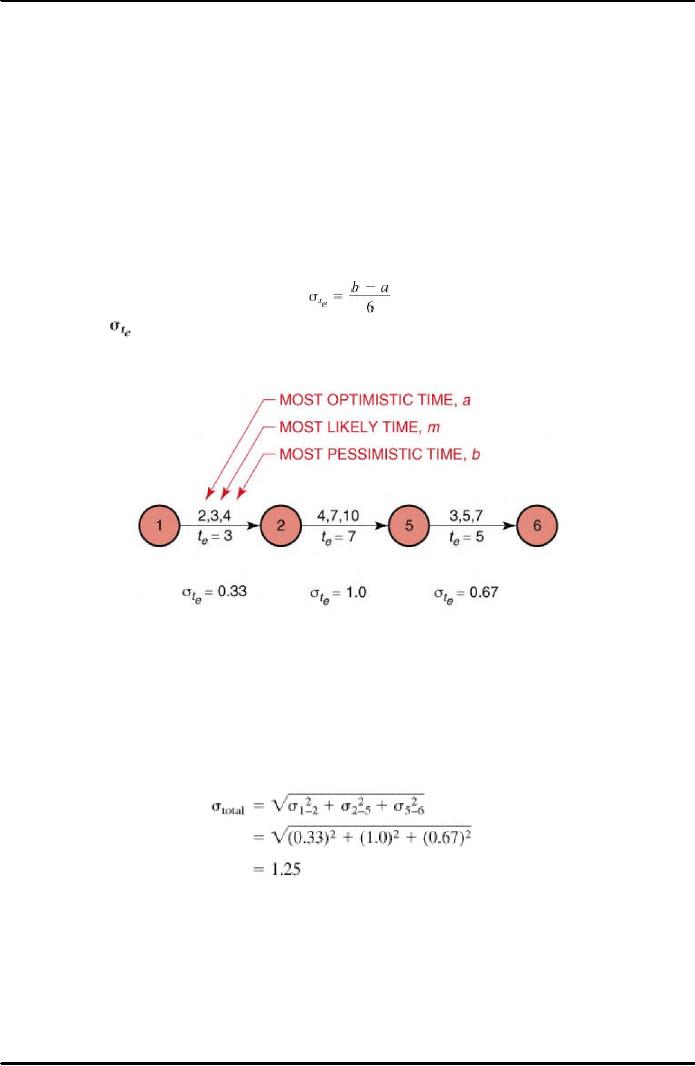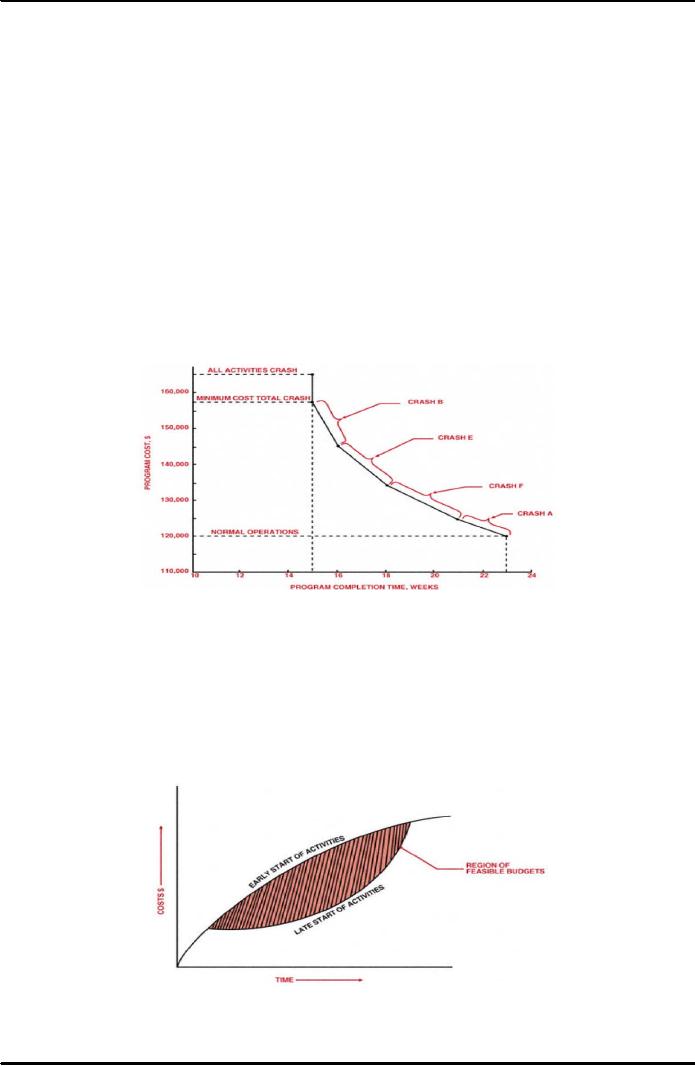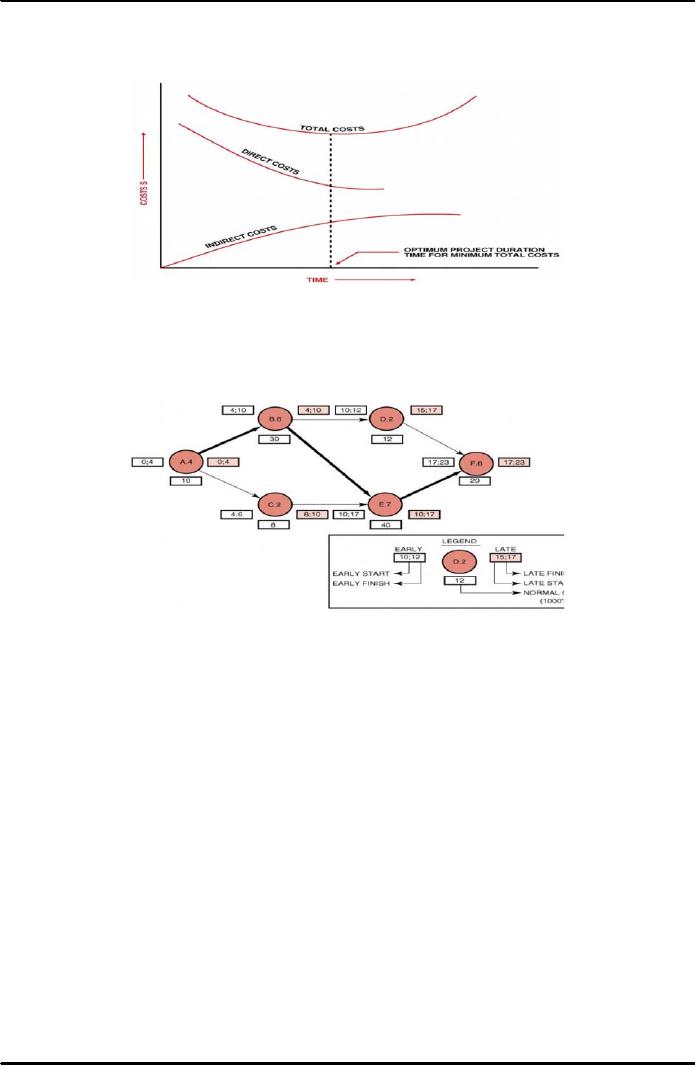 |

Project
Management MGMT627
VU
LESSON
30
NETWORK
SCHEDULING TECHNIQUES
BROAD
CONTENTS
Estimating
Activity Time
Estimating
Total Program Time
Total
PERT/CPM Planning
Crash
Times
PERT/CPM
Problem Areas
Alternative
PERT/CPM Model
30.1
Estimating
Activity Time:
In
order to determine the elapsed
time between events requires that
responsible functional
managers
evaluate the situation and
submit their best estimates.
The calculations for
critical
paths
and slack times in the previous sections
were based on these best
estimates.
Thus,
in this ideal situation, the
functional manager would have at
his disposal a large
volume
of
historical data from which
to make his estimates.
Obviously, the more historical
data
available,
the more reliable the estimate would
be. Many programs, however,
include events
and
activities that are
non-repetitive.
In
this case, the functional
managers must submit their
estimates using three possible
completion
assumptions:
�
Most
optimistic completion
time:
This
time assumes that everything
will go according to plan and
with a minimal amount of
difficulties.
This should occur approximately 1 percent
of the time.
�
Most
pessimistic completion
time:
This
time assumes that everything
will not go according to
plan and that the
maximum
potential
difficulties will develop.
This should also occur
approximately 1 percent of the
time.
�
Most
likely completion time:
This
is the time that, in the mind of the
functional manager, would most
often occur should
this
effort be reported over and
over again.
Two
assumptions must be made
before these three times can be
combined into a
single
expression
for expected time. The first
assumption is that the standard
deviation, , is one-sixth
of
the time requirement range. This
assumption stems from probability
theory, where the end
points
of a curve are three standard
deviations from the mean.
The second assumption requires
that
the probability distribution of time
required for an activity be expressible
as a beta
distribution.
The
expected time between events can be
found from the expression:
In
this, te
=
expected time, a
=
most optimistic time,
b
=
most pessimistic time, and m =
most
likely
time.
213

Project
Management MGMT627
VU
Here
we take an example. If a
=
3, b
=
7, and m
=
5 weeks, then the expected time,
te,
would be
5
weeks. This value for
te
would
then be used as the activity
time between two events in
the
construction
of a PERT chart. This method for
obtaining best estimates contains a
large degree
of
uncertainty. If we change the variable
times to a
=
2, b
=
12, and m
=
4 weeks, then te
will
still
be 5 weeks. The latter case,
however, has a much higher
degree of uncertainty because
of
the
wider spread between the optimistic
and pessimistic times. Care must be
taken in the
evaluation
of risks in the expected times.
30.2
Estimating
Total Program
Time:
It
is important to know that in
order to calculate the probability of
completing the project on
time,
the standard deviations of each
activity must be known. This
can be found from
the
expression:
is
the standard deviation of the expected
time, te.
Another useful expression is the
Where
variance,
, which is the square of the
standard deviation. The
variance is primarily useful
for
comparison
to the expected values.
Figure
30.1: Expected
Time Analysis for Critical
Path Events in Figure 29.1
(Lecture 29)
However,
the standard deviation can be
used just as easily, except
that we must identify
whether
it
is a one, two, or three sigma limit
deviation. Figure 30.1 above
shows the critical path
of
Figure
29.1 (lecture 29), together
with the corresponding values from
which the expected times
were
calculated, as well as the standard
deviations. The total path
standard deviation is
calculated
by the square root of the sum of the
squares of the activity standard
deviations using
the
following expression:
30.3
Total
PERT/CPM Planning:
It
is necessary to discuss the methodology
for preparing PERT
schedules, before we
continue
further.
PERT scheduling is a six-step
process.
Steps
one and two begin with the
project manager laying out a
list of activities to be
performed
and
then placing these
activities in order of precedence,
thus identifying the
interrelationships.
These
charts drawn by the project
manager are called logic
charts, arrow diagrams, work
flow,
214

Project
Management MGMT627
VU
or
simply networks. The arrow
diagrams will look like
Figure 29.1 (lecture 29)
with two
exceptions:
The activity time is not
identified, and neither is the critical
path.
The
next step that is step three
is reviewing the arrow diagrams
with the line managers (that
is,
the
true experts) in order to obtain
their assurance that neither
too many nor too
few activities
are
identified, and that the
interrelationships are correct.
In
step four, the functional
manager converts the arrow
diagram to a PERT chart by
identifying
the
time duration for each
activity. It should be noted
here that the time estimates
that the line
managers
provide are based on the
assumption
of unlimited resources because
the calendar
dates
have not yet been
defined.
Fifth
step is the first iteration on the
critical path. It is here
that the project manager
looks at the
critical
calendar dates in the definition of the project's
requirements. If the critical path does
not
satisfy
the calendar requirements, then the project
manager must try to shorten the
critical path
using
methods explained earlier or by
asking the line managers to
take the ''fat" out of
their
estimates.
Step
six is often the most
overlooked step. Here the
project manager places calendar
dates on
each
event in the PERT chart, thus, converting
from planning under
unlimited resources to
planning
with limited
resources.
Even though the line manager
has given you a time
estimate,
there
is no guarantee that the correct
resources will be available
when needed. That is why
this
step
is crucial. If the line manager cannot
commit to the calendar dates, then
replanning will be
necessary.
Most companies that survive
on competitive bidding lay
out proposal
schedules
based
on unlimited resources. After contract
award, the schedules are analyzed
again because
the
company now has limited
resources.
The
question arises that after
all, how can a company bid
on three contracts simultaneously
and
put
a detailed schedule into
each proposal if it is not
sure how many contracts, if
any, it will
win?
For this reason customers
require that formal project
plans and schedules be provided
thirty
to ninety days after contract
award.
Finally,
PERT re-planning should be an ongoing
function during project
execution. The best
project
managers are those
individuals who continually
try to assess what can go
wrong and
perform
perturbation analysis on the schedule.
(This should be obvious
because the constraints
and
objectives of the project can
change during execution.)
Primary objectives on a
schedule
are:
�
Best
time
�
Least
cost
�
Least
risk
In
addition to this, the secondary
objectives include:
�
Studying
alternatives
�
Optimum
schedules
�
Effective
use of resources
�
Communications
�
Refinement
of the estimating process
�
Ease
of project control
�
Ease
of time or cost
revisions
It
is quite obvious that these
objectives are limited by
such constraints as:
�
Calendar
completion
215

Project
Management MGMT627
VU
�
Cash
or cash flow
restrictions
�
Limited
resources
�
Management
approvals
30.4
Crash
Times:
So
far no distinction was made
between PERT and CPM. The
basic difference between PERT
and
CPM lies in the ability to calculate
percent complete. PERT is used in Research
and
Development
or just development activities, where a
percent-complete determination is almost
impossible.
Therefore,
PERT is event oriented rather than
activity oriented. In PERT,
funding is normally
provided
for each milestone (i.e.,
event) achieved because incremental
funding along the
activity
line has to be based on percent complete.
CPM, on the other hand, is activity
oriented
because,
in activities such as construction,
percent complete along the activity line
can be
determined.
CPM can be used as an arrow
diagram network without
PERT. The difference
between
the two methods lies in the
environments in which each one
evolved and how each
one
is
applied.
In
addition, the CPM (activity-type
network) has been widely
used in the process industries,
in
construction,
and in single-project industrial
activities. Common problems include no place
to
store
early arrivals of raw materials and
project delays for late
arrivals.
Project
managers can consider the cost of
speeding up, or crashing, certain phases
of a project
using
strictly the CPM approach. In order to
accomplish this, it is necessary to calculate
a
crashing
cost per unit time as well
as the normal expected time
for each activity. CPM
charts,
which
are closely related to PERT
charts, allow visual representation of
the effects of crashing.
There
are these following
requirements:
�
For
a CPM chart, the emphasis is on
activities, not events.
Therefore, the PERT chart
should
be redrawn with each circle
representing an activity rather than an
event.
�
In
CPM, both time and
cost of each activity are
considered.
�
Only
those activities on the critical
path are considered, starting
with the activities for
which
the
crashing cost per unit time is the
lowest.
The
following Figure 30.2 below
shows a CPM network with the
corresponding crash time
for
all
activities both on and off the
critical path. The
activities are represented by circles
and
include
an activity identification number and the estimated
time. The costs expressed in
it are
usually
direct costs only.
Figure
30.2: CPM
Network
216

Project
Management MGMT627
VU
As
shown in the figure 30.2, in order to
determine crashing costs we begin
with the lowest
weekly
crashing cost, activity A, at $2,000 per
week. Although activity C
has a lower crashing
cost,
it is not on the critical path.
Only critical path
activities are considered for
crashing.
Activity
A will be the first to be crashed
for a maximum of two weeks
at $2,000 per week.
The
next
activity to be considered would be F at
$3,000 per week for a
maximum of three weeks.
These
crashing costs are additional
expenses above the normal
estimates.
It
is important to remember a word of
caution concerning the selection and
order of the
activities
that are to crash: There is
a good possibility that as
each activity is crashed, a
new
critical
path will be developed. This
new path may or may
not include those elements
that were
bypassed
because they were not on the
original critical
path.
In
the same Figure 30.2 (and
assuming that no new
critical paths are
developed), activities A, F,
E,
and B would be crashed in that
order. The crashing cost
would then be an increase
of
$37,500
from the base of $120,000 to
$157,500. The corresponding
time would then be
reduced
from
twenty-three weeks to fifteen
weeks. This is shown in Figure
30.3 below to illustrate
how
a
trade-off between time and
cost can be obtained. Also
shown in it is the increased cost
of
crashing
elements not on the critical
path.
Figure
30.3: CPM
Crashing Costs
Crashing
these elements would result
in a cost increase of $7,500
without reducing the
total
project
time. There is also the
possibility that this figure
will represent unrealistic
conditions
because
sufficient resources are not
or cannot be made available for the
crashing period.
Importantly,
the purpose behind balancing
time and cost is to avoid
the useless waste of
resources.
If the direct and indirect
costs can be accurately obtained,
then a region of
feasible
budgets
can be found, bounded by the
early-start (crash) and late-start (or
normal) activities.
This
is shown in Figure 30.4
below.
Figure
30.4: Region
of Feasible Budgets
217

Project
Management MGMT627
VU
Since
the direct and indirect costs
are not necessarily expressible as linear
functions, timecost
trade-off
relationships are made by
searching for the lowest possible
total cost (that is,
direct
and
indirect) that likewise satisfies
the region of feasible budgets.
This method is shown in
Figure
30.5 below.
Figure
30.5: Determining
Project Duration
Note
that like PERT, CPM
also contains the concept of slack time,
the maximum amount of
time
that a job may be delayed
beyond its early start
without delaying the project
completion
time.
Figure 30.6 below shows a
typical representation of slack time
using a CPM chart.
Figure
30.6: CPM
Network with Slack
This
figure also shows how
target activity costs can be
identified. It can be modified to
include
normal
and crash times as well as normal and
crash costs. In this case,
the cost box in the
figure
would
contain two numbers: The
first number would be the normal
cost, and the second
would
be
the crash cost. These
numbers might also appear as
running totals.
30.5
PERT/CPM
Problem Areas:
Even
the largest organizations with years of
experience in using PERT and CPM have the
same
ongoing
problems as newer or smaller companies. Thus, PERT/CPM
models are not
without
their
disadvantages and problems.
Due
to its characteristics, many
companies have a difficult time
incorporating PERT systems
because
PERT is end-item oriented.
Many upper-level managers
feel that the adoption
of
PERT/CPM
remove a good part of their
power and ability to make decisions.
This is
particularly
evident in companies that have
been forced to accept
PERT/CPM as part of
contractual
requirements.
In
addition to this, there exists a distinct
contrast in PERT systems between the planners
and the
doers.
This human element must be accounted
for in order to determine where the
obligation
actually
lies. In most organizations
PERT planning is performed by the
program office and
functional
management. Yet once the
network is constructed, the planners and
managers
become
observers and rely on the
doers to accomplish the job within
time and cost
limitations.
218

Project
Management MGMT627
VU
Management
must convince the doers that
they have an obligation toward the
successful
completion
of the established PERT/CPM plans.
It
is important to note that
unless the project is repetitive, there
usually exists a lack of
historical
information
on which to base the cost
estimates of most optimistic,
most pessimistic, and most
likely
times. Problems can also involve
poor predictions for overhead
costs, other indirect
costs,
material
and labor escalation factors, and
crash costs. It is also possible
that each major
functional
division of the organization has
its own method for
estimating costs. Engineering,
for
example,
may use historical data,
whereas manufacturing operations may
prefer learning
curves.
PERT
works best if all
organizations have the same method for
predicting costs and
performance.
PERT
networks are based on the
assumption that all
activities start as soon as possible.
This
assumes
that qualified personnel and
equipment are available.
Regardless of how well we
plan,
there
almost always exist differences in
performance times from what would
normally be
acceptable
for the model selected. For
the selected model, time and
cost should be well-
considered
estimates, not a spur-of-the-moment
decision.
Another
problem is that of cost
control. It presents a problem in
that the project cost and
control
system
may not be compatible with
company fiscal planning policies.
Project-oriented costs
may
be meshed with non-PERT-controlled
jobs in order to develop the
annual budget. This
becomes
a difficult chore for cost
reporting, especially when
each project may have its
own
method
for analyzing and controlling
costs.
Furthermore,
many people have come to expect
too much of PERT -type
networks. Figure 30.7
below
illustrates a PERT/CPM network
broken down by work packages
with identification of
the
charge numbers for each
activity. Large projects may
contain hundreds of charge
numbers.
Subdividing
work packages (which are
supposedly the lowest element) even further
by
identifying
all sub activities has the
advantage that direct charge
numbers can be easily
identified,
but the time and cost for
this form of detail may be
prohibitive. PERT/CPM
networks
are
tools for program control,
and managers must be careful
that the original game plan
of using
networks
to identify prime and supporting
objectives is still met.
Additional detail may
mask
this
all-important purpose. Remember, networks
are constructed as a means for
understanding
program
reports. Management should not be
required to read reports in order to
understand
PERT/CPM
networks.
Figure
30.7: Using
PERT for Work Package
Control
30.6
Alternative
PERT/CPM Models:
Numerous
industries have found applications
for this form of network,
because of the many
advantages
of PERT/time. A partial list of
these advantages includes
capabilities for:
219

Project
Management MGMT627
VU
�
Trade-off
studies for resource
control
�
Providing
contingency planning in the early
stages of the project
�
Visually
tracking up-to-date performance
�
Demonstrating
integrated planning
�
Providing
visibility down through the
lowest levels of the work
breakdown structure
�
Providing
a regimented structure for control
purposes to ensure compliance
with the work
breakdown
structure and the statement of
work
�
Increasing
functional members' ability to
relate to the total program, thus,
providing
participants
with a sense of
belonging
Remember
that even with these
advantages, in many situations
PERT/time has proved
ineffective
in controlling resources. Earlier we have
defined three parameters necessary
for the
control
of resources: time, cost, and
performance. With these factors in mind,
companies began
reconstructing
PERT/time into PERT/cost and
PERT/performance models.
In
addition, PERT/cost is an extension of
PERT/time and attempts to overcome the
problems
associated
with the use of the most
optimistic and most pessimistic time
for estimating
completion.
PERT/cost can be regarded as a cost
accounting network model
based on the work
breakdown
structure and capable of being subdivided
down to the lowest elements, or
work
packages.
The advantages of PERT/cost are
that it:
�
Contains
all the features of
PERT/time
�
Permits
cost control at any Work
Breakdown Structure (WBS)
level
Note
that the primary reason for
the development of PERT/cost was so that
project managers
could
identify critical schedule slippages
and cost overruns in time
for corrective action to
be
taken.
In
this regard, many attempts have
been made to develop
effective PERT/schedule models. In
almost
all cases, the charts are
constructed from left to right. An
example of such
current
attempts
is the Accomplishment/Cost
Procedure (ACP).
Summing
up our discussion, unfortunately, the
development of PERT/schedule techniques is
still
in its infancy. Although
their applications have been
identified, many companies
feel
locked
in with their present method of
control, whether it is PERT,
CPM, or some other
technique.
220
Table of Contents:
- INTRODUCTION TO PROJECT MANAGEMENT:Broad Contents, Functions of Management
- CONCEPTS, DEFINITIONS AND NATURE OF PROJECTS:Why Projects are initiated?, Project Participants
- CONCEPTS OF PROJECT MANAGEMENT:THE PROJECT MANAGEMENT SYSTEM, Managerial Skills
- PROJECT MANAGEMENT METHODOLOGIES AND ORGANIZATIONAL STRUCTURES:Systems, Programs, and Projects
- PROJECT LIFE CYCLES:Conceptual Phase, Implementation Phase, Engineering Project
- THE PROJECT MANAGER:Team Building Skills, Conflict Resolution Skills, Organizing
- THE PROJECT MANAGER (CONTD.):Project Champions, Project Authority Breakdown
- PROJECT CONCEPTION AND PROJECT FEASIBILITY:Feasibility Analysis
- PROJECT FEASIBILITY (CONTD.):Scope of Feasibility Analysis, Project Impacts
- PROJECT FEASIBILITY (CONTD.):Operations and Production, Sales and Marketing
- PROJECT SELECTION:Modeling, The Operating Necessity, The Competitive Necessity
- PROJECT SELECTION (CONTD.):Payback Period, Internal Rate of Return (IRR)
- PROJECT PROPOSAL:Preparation for Future Proposal, Proposal Effort
- PROJECT PROPOSAL (CONTD.):Background on the Opportunity, Costs, Resources Required
- PROJECT PLANNING:Planning of Execution, Operations, Installation and Use
- PROJECT PLANNING (CONTD.):Outside Clients, Quality Control Planning
- PROJECT PLANNING (CONTD.):Elements of a Project Plan, Potential Problems
- PROJECT PLANNING (CONTD.):Sorting Out Project, Project Mission, Categories of Planning
- PROJECT PLANNING (CONTD.):Identifying Strategic Project Variables, Competitive Resources
- PROJECT PLANNING (CONTD.):Responsibilities of Key Players, Line manager will define
- PROJECT PLANNING (CONTD.):The Statement of Work (Sow)
- WORK BREAKDOWN STRUCTURE:Characteristics of Work Package
- WORK BREAKDOWN STRUCTURE:Why Do Plans Fail?
- SCHEDULES AND CHARTS:Master Production Scheduling, Program Plan
- TOTAL PROJECT PLANNING:Management Control, Project Fast-Tracking
- PROJECT SCOPE MANAGEMENT:Why is Scope Important?, Scope Management Plan
- PROJECT SCOPE MANAGEMENT:Project Scope Definition, Scope Change Control
- NETWORK SCHEDULING TECHNIQUES:Historical Evolution of Networks, Dummy Activities
- NETWORK SCHEDULING TECHNIQUES:Slack Time Calculation, Network Re-planning
- NETWORK SCHEDULING TECHNIQUES:Total PERT/CPM Planning, PERT/CPM Problem Areas
- PRICING AND ESTIMATION:GLOBAL PRICING STRATEGIES, TYPES OF ESTIMATES
- PRICING AND ESTIMATION (CONTD.):LABOR DISTRIBUTIONS, OVERHEAD RATES
- PRICING AND ESTIMATION (CONTD.):MATERIALS/SUPPORT COSTS, PRICING OUT THE WORK
- QUALITY IN PROJECT MANAGEMENT:Value-Based Perspective, Customer-Driven Quality
- QUALITY IN PROJECT MANAGEMENT (CONTD.):Total Quality Management
- PRINCIPLES OF TOTAL QUALITY:EMPOWERMENT, COST OF QUALITY
- CUSTOMER FOCUSED PROJECT MANAGEMENT:Threshold Attributes
- QUALITY IMPROVEMENT TOOLS:Data Tables, Identify the problem, Random method
- PROJECT EFFECTIVENESS THROUGH ENHANCED PRODUCTIVITY:Messages of Productivity, Productivity Improvement
- COST MANAGEMENT AND CONTROL IN PROJECTS:Project benefits, Understanding Control
- COST MANAGEMENT AND CONTROL IN PROJECTS:Variance, Depreciation
- PROJECT MANAGEMENT THROUGH LEADERSHIP:The Tasks of Leadership, The Job of a Leader
- COMMUNICATION IN THE PROJECT MANAGEMENT:Cost of Correspondence, CHANNEL
- PROJECT RISK MANAGEMENT:Components of Risk, Categories of Risk, Risk Planning
- PROJECT PROCUREMENT, CONTRACT MANAGEMENT, AND ETHICS IN PROJECT MANAGEMENT:Procurement Cycles